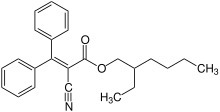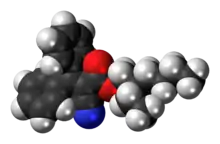Octocrylene
Octocrylene is an organic compound used as an ingredient in sunscreens and cosmetics. It is an ester formed by the reaction of 3,3-diphenylcyanoacrylate with 2-ethylhexanol. It is a viscous, oily liquid that is clear and colorless.
 | |
 | |
| Names | |
|---|---|
| IUPAC name
2-ethylhexyl 2-cyano-3,3- | |
| Other names
Octocrylene Octocrilene Uvinul N-539 | |
| Identifiers | |
3D model (JSmol) |
|
| ChEMBL | |
| ChemSpider | |
| ECHA InfoCard | 100.025.683 |
PubChem CID |
|
| UNII | |
CompTox Dashboard (EPA) |
|
| |
| |
| Properties | |
| C24H27NO2 | |
| Molar mass | 361.48 g/mol |
| Density | 1.05 g/cm3 |
| Melting point | 14 °C (57 °F; 287 K) |
| Boiling point | 218 °C (424 °F; 491 K) at 1.5 mmHg |
Except where otherwise noted, data are given for materials in their standard state (at 25 °C [77 °F], 100 kPa). | |
| Infobox references | |
The extended conjugation of the acrylate portion of the molecule absorbs UVB and short-wave UVA (ultraviolet) rays with wavelengths from 280 to 320 nm,[1] protecting the skin from direct DNA damage. The ethylhexanol portion is a fatty alcohol, adding emollient and oil-like (water resistant) properties.
This organic compound can penetrate into the skin where it acts as a photosensitizer. This results in an increased production of free radicals under illumination.[2]
In coral, octocrylene has been shown to accumulate in the form of fatty acid conjugates and trigger mitochondrial dysfunction.[3] Also, it has been demonstrated that octocrylene passes through the skin in human experiments, enters blood stream, is metabolized and eventually excreted in urine in form of its metabolites.[4][5] The country of Palau banned the sale and use of 3 reef toxic UV filters including octocrylene in its Responsible Tourism Education Act of 2018.[6] Earlier in 2019, the U.S. Virgin Island also banned the sale and use of oxybenzone, octinoxate, and octocrylene.
References
- Smart Skin Care: Octocrylene
- Hanson Kerry M.; Gratton Enrico; Bardeen Christopher J. (2006). "Sunscreen enhancement of UV-induced reactive oxygen species in the skin". Free Radical Biology and Medicine. 41 (8): 1205–1212. doi:10.1016/j.freeradbiomed.2006.06.011. PMID 17015167.
- Stien, Didier; Clergeaud, Fanny; Rodrigues, Alice M.S.; Lebaron, Karine; Pillot, Rémi; Romans, Pascal; Fagervold, Sonja; Lebaron, Philippe (2019). "Metabolomics reveal that octocrylene accumulates in Pocillopora damicornis tissues as fatty acid conjugates and triggers coral cell mitochondrial dysfunction" (PDF). Analytical Chemistry. 91 (1): 990–995. doi:10.1021/acs.analchem.8b04187. PMID 30516955.
- Bury, Daniel; Belov, Vladimir N.; Qi, Yulin; Hayen, Heiko; Volmer, Dietrich A.; Brüning, Thomas; Koch, Holger M. (2018). "Determination of urinary metabolites of the emerging UV filter octocrylene by online-SPE-LC-MS/MS". Analytical Chemistry. 90 (1): 944–951. doi:10.1021/acs.analchem.7b03996. hdl:21.11116/0000-0000-3212-3. PMID 29188988.
- Bury, Daniel; Modick-Biermann, Hendrik; Leibold, Edgar; Brüning, Thomas; Koch, Holger M. (2019). "Urinary metabolites of the UV filter octocrylene in humans as biomarkers of exposure". Archives of Toxicology. 93 (5): 1227–1238. doi:10.1007/s00204-019-02408-7. PMID 30739143. S2CID 59622082.
- Republic of Palau. PalauGov.pw Your guide to finding and using Palau National Government services https://www.palaugov.pw/documents/rppl-no-10-30-the-responsible-tourism-education-act-of-2018/. Retrieved 16 October 2019. Missing or empty
|title=(help)